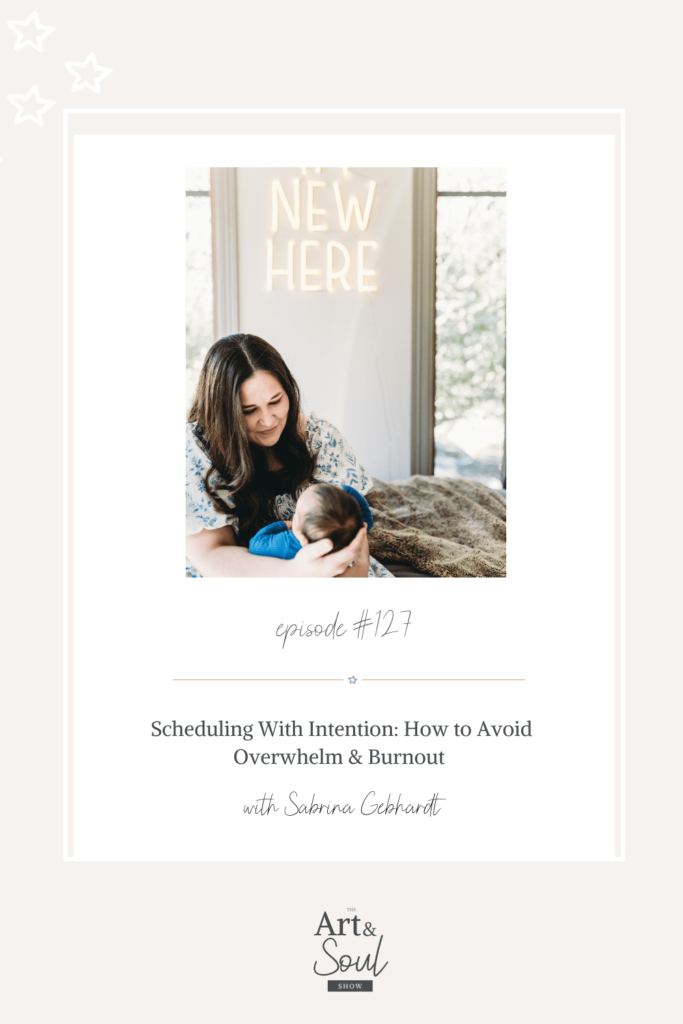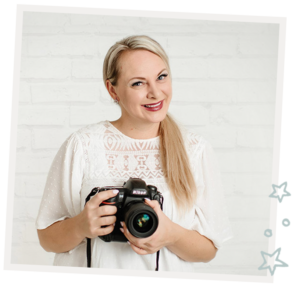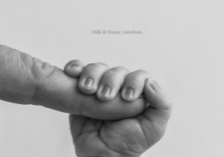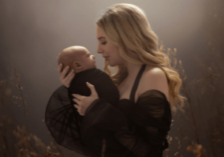Scheduling With Intention: How to Avoid Overwhelm & Burnout with Sabrina Gebhardt
It’s easy to get caught in the neverending cycle of scheduling, shooting, editing, repeat. While these tasks are important, this cycle can lead to burnout and overwhelm, causing you to lose sight of your passion for your craft. So how do you break the cycle and build a business you love?

In this episode, I chat with Sabrina Gebhardt, a business coach who helps fellow photographers minimize overwhelm by scheduling their businesses with intention.
Sabrina shares her tips for avoiding burnout and surviving periods of overwhelm. She explains how to set firm boundaries, both with your clients and with yourself. She shares her tips for creating more white space in your calendar, as well as scheduling strategies to help prevent overbooking. We also talk about the importance of taking breaks in order to fall back in love with your business.
What’s in this episode:
- How to avoid burnout as a photographer and business owner [2:39]
- How to survive periods of overwhelm and manage it as it comes [7:31]
- How to set boundaries with your clients and learn to put yourself first [12:02]
- Why it’s important to set boundaries now to protect your “future self” [16:16]
- Sabrina’s tips and tricks for staying on task and managing your time [19:25]
- How to reignite your passion when you get bogged down in the day-to-day [23:53]
- How to work smarter, not harder [28:59]
- Sabrina’s free training to teach you how to minimize overwhelm and run your business with intention [33:36]
If you want to ditch your overwhelm and create a business that fuels instead of drains you, tune in to this episode.
SUBSCRIBE: iTunes | Spotify | Stitcher
Resources Mentioned
Sabrina’s free course, Frustrated to Flourishing
Facebook News Feed Eradicator Chrome extension
American Dirt, Sabrina’s favorite book
Meet Sabrina Gebhardt
Sabrina Gebhardt is a lifestyle newborn and family photographer of more than 11 years. She has been mentoring and coaching for the last 6 years and loves to talk all things business. Sabrina loves joy, color and a splash of chaos mixed in for fun. She is sustained by morning workouts, lots of coffee and getting in bed super early to read. Sabrina lives in Fort Worth, Texas with her 3 kids, 2 pups and husband of 17 years.
Connect with Sabrina
Did you love hearing Sabrina’s tips for scheduling with intention and setting boundaries in your business? Check out another episode from Jenna Henderson
Transcript:
[00:00:00] Sabrina Gebhardt: Because I feel like that’s the hard part is when you’re put on the spot and you’re having to come up with something, right? Then it’s the deer in the headlights. And so, like I was saying, like preparing things ahead of time when I’m clear headed, when I’m thinking straight, when I know what my intentions are, what I want and what I don’t want. If I can package all of that stuff into canned emails or pre-planned responses or pages on my website or whatever, that sets my future self up for success because I’m not having to come up with ways to say no on the spot.
[00:00:34] Lisa DiGeso: Welcome to the Art and Soul Show, where we dove into heart opening chats on photography, business, life and that messy in between. I’m your host, Lisa DiGeso, a mom, a photographer and entrepreneur, and I’ll be sharing honest conversations and advice for photographers with insight on mindset, entrepreneurship and creativity. The goal of this podcast is for you to be able to gain insights and strategies that will get you real results. Because, let’s face it, having a photography business can be lonely, but it doesn’t have to be. This is the place you can go when you need a boost of encouragement, a kick in the pants and inspiration to pick up your camera. This is the Art and Soul Show. Hello, my beautiful friends. Welcome back to the show. Today, I’m hanging out with Sabrina Gebhardt. She’s a lifestyle newborn and family photographer of more than 11 years. She’s been mentoring and coaching for the last six years and loves to talk about all things business. She loves joy, color and a splash of chaos mixed in for fun. She has sustained morning workouts, lots of coffee and getting in bed super early to read. She lives in Fort Worth, Texas, with her three kids, two pups and husband of 17 years. Without further ado, here is Sabrina.
[00:01:50] Sabrina Gebhardt: Hi. I’m so glad to be here.
[00:01:54] Lisa DiGeso: So tell us who you are and what you’re passionate about.
[00:01:58] Sabrina Gebhardt: Yeah. So like you just said, I’m a lifestyle photographer and business coach and I am super passionate about helping photographers build something that is successful and sustainable that serves them. I love in the process to build communities of women who end up becoming like business besties. I love connecting the dots for people, and I love showing women that we all struggle with the same things, and that’s totally normal. Basically, I really want to be like a champion for female photographers to succeed and to succeed. Well, for them and their lives.
[00:02:39] Lisa DiGeso: Awesome. That’s what I’m driven about, too. I love it. So burnout in our industry really is a real thing. And I know our listeners and truth be told, I often have burnout periods too. So this becomes sort of the last thing I really want to do is work on my business, even though that’s what I should be doing. So what advice do you have for avoiding even getting to burnout or what to do and how to get yourself out of it?
[00:03:02] Sabrina Gebhardt: Yeah. So to answer the first part of avoiding burnout, the biggest advice I have is to stop overscheduling yourself. And that’s work, but also play and life just. I feel like females and moms and entrepreneurs, we want to do all the things and touch all the things and and just have our hands in so many places and we are so guilty of that. But the thing about it is, when we start treating our schedule in a way of being proactive instead of reactive, then we take control, right? And we stop overscheduling. So being proactive looks like planning for time off. Planning for time with my family, and then not being persuaded to put clients into every single hole that’s on the calendar. Right. Because as photographers, we’re like, well, technically I don’t have anything Thursday night. So I mean, I could put a client there, could make a little extra money, but that’s when we get stuck. When we do that over and over and over again. And we stop looking at Thursday night as my downtime with my husband and my kids, and I’m just throwing sessions into every slot. That’s when we hit burnout. But to answer the second part of your question, how to get out of burnout. This is a kind of tough pill to swallow, especially for the Enneagram threes, the doers out there. You really have to be able to pull back and take a step away for a bit. And I don’t mean to take a day off. I mean, like, weeks off. Maybe a month off. Yeah. And. I get that we have to sustain our families financially. So maybe not pulling all the way back, but being willing to pull back to 10% capacity, 15% capacity, so that all of a sudden we have tons of room. Room to recover because burnout, oftentimes at its worst is depression and it’s like burnouts, the buzzword. But when you really look at what it feels like and what it does is depression and you need time, you don’t just need like an afternoon to recover from that. Right now. It’s hard to say, you know what, I have to stop. I have to carve out this two, three, four week time where I’m going to allow myself to recover. But you have to. And the thing about it is taking that time and not not filling it with other things, not filling it with a big family vacation or renovating your home or signing up for all the kid stuff, but really taking it and letting yourself be bored, letting yourself have nothing. And that’s where your nervous system comes down and you can start to heal yourself and get that creative fire back.
[00:05:56] Lisa DiGeso: I love that so much and you just nail it on the head right there. I’m like, That’s exactly what I do. I will load my schedule. And then I’m like, No, no, no, nobody’s getting any of these sessions. But then instead of just resting and letting myself recover, I just add all these other activities. And so it’s just busy. Just a hamster wheel of busy.
[00:06:13] Sabrina Gebhardt: Yeah, yeah, I get it. I mean.
[00:06:16] Sabrina Gebhardt: I’m in Enneagram Three and I do not sit still well. I do not. I like literally I’m like, well, I mean I could be doing this or this or maybe I should start this new project. You know, and it’s really training yourself that you need this and it is okay for this and just starting to allow yourself to have that time. And once you start to settle in, your body’s like, Oh, okay, we understand rest and recovery and downtime, but it’s getting yourself to actually do it. That’s so hard.
[00:06:50] Lisa DiGeso: It’s so hard. And it’s funny. Like, I think that, you know, we are just inundated with this hustle culture and this like busy. Busy is a good thing and I’m like, busy is not a good thing. It doesn’t feel good. Like, I feel scattered and I feel disorganized. And just like having those times, like Freedom Fridays or like, yeah, just mindful Mondays, just like that time where you can just take and just say, you know what, nothing’s scheduled, nothing’s on the grid, and maybe I’ll go for a hike. Maybe I will just sit and read a book in my backyard or have a picnic.
[00:07:18] Sabrina Gebhardt: Exactly like. Yeah, exactly.
[00:07:21] Lisa DiGeso: We just, if we load our schedules. We don’t leave ourselves the opportunity for having the little surprises and the delights in life.
[00:07:29] Sabrina Gebhardt: Exactly. I agree 100%.
[00:07:31] Lisa DiGeso: So I love that. So overwhelm is also a really big topic that we hear from our listeners. So what advice do you have for moving through overwhelm and being able to take action?
[00:07:41] Sabrina Gebhardt: Yeah, overwhelm is so big. And the first thing I want to say is overwhelm is not something that you ever permanently get out of. It ebbs and flows with seasons of life, right? With kids and family stuff and moves and births and business. I mean, it’s just it’s an ebb and flow. So really having some tools to understand how to manage overwhelm is really the key. I don’t think you can ever avoid it altogether like life happens, right? So yeah, what I think is the most important is figuring out why you’re overwhelmed, like being able to name what is the trigger to the overwhelm. And maybe it is. All the things are happening at once, but most likely there is something that is the culprit. You know, you’re shooting too much. You’re trying to do everything yourself. Maybe you’re trying to fit into this photographer box that you don’t fit into. Maybe you’re doing the kind of work that you don’t love. Maybe you need help with your kids. You know, there’s generally some specific thing that’s the route. And so when you figure out what that is, then you can solve a problem. You can find a solution to that problem. So figuring out what the problem is and then being willing to commit to making whatever change you need to make, which is often where we get stuck because it probably involves either pulling back or saying no or spending money and hiring someone. And for somebody who’s newer in business, they don’t want to do any of those things. You know? And so oftentimes they will just hustle through and just keep going and push it aside. I’m fine, right. But being willing to figure out that you are handling too much or there’s too much pressure in one area and then solving that problem. So another thing that you can do is try to work in new systems or routines or automations that will serve you and support you and kind of take some things off your plate. So, for example, this is a routine, but it’s. You’ve always done sessions every Saturday and you are feeling really overwhelmed with the lack of weekend time you have, the lack of recovery time, you have the time away from your family. Then maybe you should try shooting only one weekend a month and pulling back from the rest. That does look like shifting your availability, maybe telling clients no, and that’s hard, but being willing to try that for a period of time and see if that removes the overwhelm so that you are a better human, a better wife, a better mom, a better photographer. You can serve your community and your clients better. So making those changes and finding, being willing to find new systems and rhythms that can work for you. And then lastly, giving yourself grace to revisit what’s working and what’s not working in different seasons. Because what works for you now may not work for you in six months because your kids have gotten older or they’re playing different sports or you know, you’ve got a husband that’s traveling now or whatever it is. When we find a system that works for us, we still have to have the flexibility to constantly reevaluate because life changes and our needs change.
[00:10:53] Lisa DiGeso: Yeah, it’s so true. I love how you talked about the triggering there. And it was funny because something immediately popped in my head and I’m like, what’s really overwhelming me right now is my flippin message box, my Facebook inbox. It’s not from clients, it’s from students, it’s from everyone. And I was like, Okay, so what is the trigger here? I’m like, It’s that I feel like I have to respond to everything and I don’t have the time right. But yet the message is still there. And I’m like, what? The problem is the message is the access and the expectation.
[00:11:22] Sabrina Gebhardt: Yeah. Yeah. So being willing to problem solve through that, like can you hire somebody to manage that for you? Can you can a bunch of the most frequently asked responses and just auto send them out can you. Yeah. Only look at that one afternoon a week for one hour and whatever you get to and the rest you don’t you know like being willing to kind of problem solve and creative think your way around that specific trigger can be really powerful.
[00:11:48] Lisa DiGeso: Yeah it completely because I’m like you know what I could do is instead of having clients thinking they can message me at night at 9:00 at night, I’ve got this idea, like send me an email, look at exactly business hours like, that’s all I have to say.
[00:12:00] Sabrina Gebhardt: Yeah, exactly, exactly.
[00:12:02] Lisa DiGeso: Which actually kind of leads me to my next question about boundaries, because I think that I know a lot of our listeners struggle with setting and sticking to boundaries too. So what advice do you have on this?
[00:12:14] Sabrina Gebhardt: Yeah, boundaries are hard. I can sympathize and boundaries are really hard. And one of the things that made the biggest impact for me around the thought of boundaries and being able to tell people know or potentially disappoint people was that if I’m not putting myself first, then I am automatically putting my clients first. And while that is good within a session situation or within certain certain situations, overall, that’s not right. Myself and my health and my family come before my business and the great clients that we love understand that. And when you put boundaries in place that serve both of you, nobody complains. There’s no losers. Everybody wins. Right? So it was really just that aha moment of, okay, one of us is coming first. Who am I putting up on the top of the list? Right. It’s got to be me and my family. And so just learning to think about it that way made such a big difference. Yeah. Another thing that I’ve learned over the years from both myself and my students is that oftentimes the boundaries we struggle with the most are the ones that we are setting for our business. Right? Like we have our CEO hat on and we’re creating these quote unquote boundaries, but then we are responsible for upholding the boundaries. Okay. So we are struggling with this thing that we’ve created and. We are almost causing the problem ourselves. Right. So it’s, for example, going back to the Saturday thing. If I decide that I’m no longer going to shoot on Saturdays and that’s going strong, and two months from now I get an inquiry for a Saturday session, maybe it’s been a slow month, maybe I’m tempted to book that spot, even though I know I’m going to miss some family thing and I’m going to hate myself later. I created the boundary. It’s my responsibility to hold the boundary, but I’m going to take that client and stick it in there. Right? So for me, that means putting boundaries in place that protect myself from my future self. Okay. So it’s not just the boundaries for my clients, but it’s the boundaries that will act as a stop sign for myself. Like, wait a minute, Sabrina. You put this boundary in place. Don’t forget, you need to stick to it. You’re going to hate yourself if you don’t. Okay. So for me, I have some fancy systems and some, you know, get over situations, but they work for me, okay? Some of them are if I’m going to have a maximum of two sessions per week. Okay. That’s my happy spot for me. I will literally take a hot pink sharpie to my paper planner when I have hit two sessions per week and I will draw a huge line on that week that says Book two is really big. So when I get a client inquiry, I’m flipping through my planner looking for the first week that does not have the hot pink sharpie line. It is such a simple thing, but it’s a flag. It’s a trigger that reminds me. No, you are at capacity for that week. Right. Another thing that I do is I have canned emails and I’m sure you do too, but I have all kinds of canned emails, especially around boundaries. And that really helps me not have to think of a way to say no to somebody. In the heat of the moment when I’m really tempted, I literally just copy, paste, copy and paste the appropriate situational email. And I put it in and I don’t have to fumble over my words, maybe get talked into doing something I don’t want to do. And again, it just saves myself from myself. Okay. So those are the boundaries that personally I have seen the most struggle with is how can we hold on to the boundaries we’ve created, like putting a system in place, you know, like a little stop sign that’s like, wait a minute, remember? So what about you?
[00:16:16] Lisa DiGeso: Well, you know, what’s funny is I actually really struggle with it in person. I’m totally fine with my boundaries when I email. I can catch myself in person and I like I’ve actually committed that I’m not shooting this fall. Yeah. And then of course, I have my clients be like we just we really just want one family photo. Like, you don’t have to do that like everything else. Like, we just really just want that one. And I’m like, Oh. Yeah, maybe. Well, I really want to say no.But they get me in person, and I just don’t want to say no to their face. It’s hard. That’s something like that’s where I really struggle. Like, instead of saying, maybe what I need to say is, Oh, send me an email.
[00:17:00] Sabrina Gebhardt: Yeah, right. Just send me an email. We’ll talk about it later, you know. But also have you tried having a response ready for when you get asked that? Like, here’s my answer. My answer is going to be, I would love to photograph you in August or January, you know, or whatever that is, so that you’re not put on the spot. Because I feel like that’s the hard part is when you’re put on the spot and you’re having to come up with something, right? Then it’s the deer in the headlights. Yeah. And so like I was saying, like preparing things ahead of time when I’m clear headed, when I’m thinking straight, when I know what my intentions are, what I want and what I don’t want. If I can package all of that stuff into canned emails or pre-planned responses or pages on my website or whatever, that sets my future self up for success because I’m not having to come up with ways to say no on the spot.
[00:17:54] Lisa DiGeso: Yeah, I remember I was asked, it’s actually just a couple of months ago I was asked to do headshots and I’m like. I don’t do headshots. Like I’m a maternity and newborn photographer like that. I really do. And I was just kind of like I kind of just fumbled over it. And then I was like, Well, I’m sorry. Like, I don’t do that, but I still have this, like, guilt of saying no. Like, like I was being ungrateful, for they wanted to pay me and give me money, but I’m like, No, no, I don’t do that. Right? And I’m just like, what? And I had like a mind –
[00:18:27] Sabrina Gebhardt: Yeah, I know we are so hard on ourselves because as entrepreneurs, when somebody wants to give us money, I mean, how dare we say no thank you? But at the end of the day, like, would you have been able to serve them? Well, I mean okay, probably, but it would not be your favorite or best. And so like doing you’re doing them the favor, you know. I actually used to have a really hard time turning down session types that I don’t do now. I’ve said no so many times that I have like I have zero problem, you know, I mean, my husband is an attorney and he owns his own practice and they need new headshots. And I won’t take them. I directed them to someone else. Nope, I don’t even do them for you.
[00:19:09] Sabrina Gebhardt: It’s not my zone, right? Yeah, right.
[00:19:11] Lisa DiGeso: No, it’s not my zone of genius. And I, like. Like, does this feel. Just feel like this? Like, is joy? Like, brings me joy or is this like, soul sucking? And if it’s also looking like I don’t want to do that, like, right. You can’t pay me enough to do that.
[00:19:23] Sabrina Gebhardt: Exactly. Exactly.
[00:19:25] Lisa DiGeso: Yeah. Anyways, so I get to be totally honest, time management really is probably my kryptonite. I get easily distracted and I often find myself just down a rabbit hole. Somehow I end up on like tick tock or YouTube instead of actually focusing on a task. So what tricks or tips do you have to manage your time effectively and stay on track with your scheduling?
[00:19:46] Sabrina Gebhardt: Yeah, so we live in a distracted world and I mean, we all get distracted. I, it’s, it takes everything in my power to get on Instagram, share something, and then get right back off because you get sucked into the things. So there’s two things to share. One, regarding Instagram, and this actually works so well for me when I’m in a rhythm for doing it, I will get on my little Apple Watch and I will say I will set a timer for 3 minutes, 5 minutes, 7 minutes. However much time I have, it’s never more than 7 minutes. Set a timer for 7 minutes and I will engage on Instagram until my watch buzzes and then I shut it down. And that has been so good for me because I feel like I’m participating, but I’m getting that physical vibration reminder trigger to get off. And so actually if I’m going into a time where I’m launching something and I want to really ramp up my Instagram engagement, I will set an alarm on my phone to do that twice a day. So I’ll do it in the morning and then in the evening, and then I’ll try and stay off. Does that mean I’m not getting on Instagram stories? No. I will still pop on here and there, but it kind of protects me from getting stuck in the scroll, right? It sets a really intentional thing and it’s the simplest practice, but something about that vibration triggers on my wrists and it’s literally like, Oh yeah, it.
[00:21:07] Sabrina Gebhardt: Jolts you out of it. You’re like, okay, done. The other thing I love is there is an app called The Focus Keeper app. You can have it on your desktop and also on your phone. I’m pretty sure it’s free because I don’t pay for many apps, but it is a 25 minute timer and it literally is the simplest thing in the whole world and it turns red and you hit play and then 25 minutes and then it turns blue and you have a four minute break. And it goes through this cycle all day if you want it to. But the key to it is if you’re going to sit down and write blog posts or create content of some sort or whatever it is that you’re trying to power through and really focus on, you shut everything else down. All the tabs, all the windows, all the notifications, the phone is on, do not disturb. And you turn on that little timer, whether it be on your phone, like looking, you know, sitting next to you or on the desktop app. And you do only the thing until the timer goes off. And so you’re telling yourself, I only have to work on this thing for 25 minutes and then I get a break. Something about that 25 minute container, I promise you, you get into a rhythm and you’re like, Oh, I’m cranking out blog posts, I’m cranking out content. It is flowing, I’m rocking and rolling. Nine times out of ten, you skip the four minute break because you are in flow at that point and working on something with such intention with everything else turned off is so dang powerful. So powerful. And then the thing about it is, if you do take the four minute break, you should physically get up and change locations. So not switching from your blog post to opening your email tab. But again, kind of like with the vibrating watch timer physically moving your body and saying, I’m going to go unload the dishwasher, I’m going to get up and go walk the dog. I’m going to physically do something else and let your brain do a totally different type of work for 4 minutes. And then you sit back down and you get right back into it. That has been a game changer for me, that app.
[00:23:10] Lisa DiGeso: Yeah, I love that. Have you heard of Facebook Feed Eradicator? It’s a Chrome Extension.
[00:23:15] Sabrina Gebhardt: No.
[00:23:16] Lisa DiGeso: It is fantastic. And so what it does is like when I need to be checking something on Facebook but not actually being in Facebook like messages or something like that. I don’t actually see the feed. Nothing is there. It just has this bubbly little quote and it’s, oh, my gosh, I don’t just sail off into oblivion. Okay. That’s amazing. Yeah, it’s called Facebook Feed Eraticator. And looking at that extension, okay.
[00:23:40] Sabrina Gebhardt: There are some really cool extensions, by the way. Like when you go down the Chrome extension rabbit hole. There’s some really fantastic stuff there. Okay. I’m going to check that one out. That’s awesome.
[00:23:52] Lisa DiGeso: So I think a lot of photographers, me included, get kind of stuck in that never ending loop of book, shoot, edit, rinse and repeat, and it starts to feel a little monotonous. Do you have any suggestions on reigniting your passion when you feel like it’s dwindling?
[00:24:05] Sabrina Gebhardt: Yeah. So two things. One of these I’ve already mentioned today, but taking time off there is beauty and pulling back from your regular day to day. The example I give my students often is when children are bored and they come up with these crazy games and they build forts and they start running wild. That is literally what time off does for adults. It’s the boredom that is allowing your imagination and your creative spirit to come alive. When we are bogged down with a thousand to-dos and a thousand meetings and clients and editing and all of these things, it is so much noise in our brain. Yeah, that there is no room for creativity. There is no room to bloom, there is no room for anything other than stay afloat. Stay afloat. Right. So time off and boredom is huge for just falling in love with what we do. Again, taking photos for the sake of taking photos. Right. Or maybe that’s when all of a sudden you’re going to have a passion ignited for something that you didn’t even know was there. Right. So the key is earlier I talked about taking chunks of time off to recover from burnout. This is taking consistent time off. Right. So an afternoon a week like you were saying, you know, time off on Mondays or Fridays or whatever, just to allow yourself to enjoy life and be a human and step away from everything else. So that’s huge. And the other thing that I really love and I feel like it gets a bad rap. I love a good old fashioned model call. I have been doing this for so long, but I will still do a couple of model calls every year because I want to call the shots and I want to try weird stuff and do stuff that I’ve never done and get creative just for the fun of it. And I feel like it gets a bad rap after you’re out of the first few years of your business because, oh my gosh, why would you do sessions for free when you don’t need to? That’s looking at the wrong way, right? You’re right, I. Don’t need to. I want to. I want the space. I want to lay and to create. And so allowing myself the time to put together a model call. Think through what I want to do. Plan the time on my calendar, and then allow myself to go into it. Just really excited and ready to play. You know, I think it’s so valuable.
[00:26:37] Lisa DiGeso: Yeah, I love that. This past week, actually in February, I found this really neat, rustic cabin that was about an hour away from my house. And I love fine art children portraits so much. I love spending that hour editing this amazing piece. Right. And so I nearly talked myself out of it, like, probably a hundred times. How many times I almost canceled it and all of like the resistance and everything that came up. Finally, I did my model call. I was like, I’m going to do this, I’m going to do this. And I did it and my friend was there. She’s like, You were glowing like, you want me. And she’s like, I’ve ever seen you this happy just doing what you love to do. And she’s like, Your voice changes too when you work with kids. I hope you know that. I was like, Oh yeah, I’m fully aware. But she’s like, it was like, I’ve never seen you that happy. And so I was like, you know, it’s been so long since I did a personal project. Yeah, and it’s so true. Like, I feel really excited about what I shot, and yet I’m so excited to go edit it and I forget how good that feels.
[00:27:44] Sabrina Gebhardt: Yeah, exactly. And it also doesn’t have to be, it doesn’t have to be a model call for anything extravagant either. Sometimes just having a family or a couple to work with where there’s no pressure of performing or turning anything specific in is so freeing. And as creatives, I at least speaking for my from myself, all of my best work has come from model call situations because there is no pressure and I’m able to step outside of my comfort zone, my regular rhythm, my shot list, you know, and I’m able to just do whatever and it shows. And I think just the creative freedom that comes from that is huge. But photographers who’ve been in business for years and years often don’t have the time in their schedule. And so it really comes down to intentionally saying, I’m going to do one in August and December or whatever, and then like really letting yourself plan for that time, which probably means saying no to a paid job so that you have time to do it. It’s going to serve you and your creativity well, even if there’s not a paycheck directly attached to it. You know, it’s so important. So important.
[00:28:59] Lisa DiGeso: So what suggestions do you have to work smarter and not harder?
[00:29:03] Sabrina Gebhardt: The common buzzword is batching, but I think it really does work. There is, like I mentioned earlier, there is value in letting your brain focus on one thing at a time. But what I have found is that the people that push back against the batching theory, the people are like, I can’t do that. It doesn’t work for me. It’s because they’re looking at it from I either have to batch everything or nothing. It’s like an all or nothing thing and that is totally not true. You cannot 100% batch this over here and nothing else like finding what works for you. For me, blogging and social media content. When I batch that stuff, it is Goldstar. It is fantastic. When I try and, you know, fit that into everything else, it’s super mediocre, right? My brain works really well doing that content creation in batching in busy seasons. I will also batch my editing in my calling so that I’m not glued to my computer. I’ll give myself a couple of days to do that and then I walk away, which is really good for my brain and my eyes. But photographers realize that you don’t have to batch everything. There are people that do and you’ll see their beautifully color coded calendar with, you know, all of these batches of batch blocks. You don’t have to do it that way. You can find a batching system that works for you. And I generally will say, start with what you are struggling with the most. Just try bashing that one thing. For a lot of photographers, it is either blogging or the social media content. Try batching one of those things and just see how it feels after a few weeks. Is it easier? Does it feel lighter? Does it take something off your plate?
[00:30:50] Lisa DiGeso: I love batching so much. We batch everything. We batch like my son’s lunches for the week. We batch everything we can. Batch.
[00:30:56] Sabrina Gebhardt: Yeah. I love it, too. I mean, it makes life so easy, you know, it just. I think it makes things a lot simpler for sure.
[00:31:06] Lisa DiGeso: I think so too. Already so. Ready for the lightning round?
[00:31:09] Sabrina Gebhardt: Yeah.
[00:31:10] Lisa DiGeso: Okay. Go to karaoke jam.
[00:31:12] Sabrina Gebhardt: Okay. So I don’t do karaoke, but I do sing all day long. So whatever’s playing. Whatever Alexa’s plays or is on the car radio, if I know the words, I am singing along to it.
[00:31:28] Lisa DiGeso: I love it. Most luxurious vacation you’ve ever been on.
[00:31:30] Sabrina Gebhardt: So when I was pregnant with my oldest, we went on a babymoon to Paris for ten days, and because we were there in one city for ten days, we took a really slow pace. We only did one site per day and then we built in naps and all of this downtime. And so it was the best of both worlds, like. Paris. Yet also super slow and restful. It was a dream.
[00:31:58] Lisa DiGeso: So great. Favorite TV show as a kid.
[00:32:01] Sabrina Gebhardt: Probably Saved by the Bell.
[00:32:06] Lisa DiGeso: Yes, same. Last thing you did for yourself was indulgence.
[00:32:11] Sabrina Gebhardt: So just this past Saturday, I got an 80 minute massage, and it was a dream. It was a total dream.
[00:32:22] Lisa DiGeso: Love that. Your favorite book.
[00:32:24] Sabrina Gebhardt: So my favorite book is called American Dirt. Have you heard of this book?
[00:32:29] Lisa DiGeso: No.
[00:32:30] Sabrina Gebhardt: Okay. So it is a story about border crossers and it’s not a true story, but it’s very heavily based on a true story. But it’s about border crossers who are escaping from gangs and poverty in Mexico and trying to come to America. It is beautifully written and an amazing story and also totally horrifying because of what’s happening in our world. But if you have not read it, you can read it in like three days. It is such a fantastic book, American Dirt.
[00:32:56] Lisa DiGeso: I’ll check it out. What did you want to be when you grew up?
[00:32:59] Sabrina Gebhardt: So ironically, a photographer.
[00:33:05] Lisa DiGeso: I love it. Yep, yep. That’s awesome. Favorite movie.
[00:33:06] Sabrina Gebhardt: So that’s up. Probably either Pride and Prejudice, the one with Keira Knightley or The Holiday. Those are the two that I watch. Repeat.
[00:33:18] Lisa DiGeso: Year round.
[00:33:20] Sabrina Gebhardt: Yeah. Yeah.
[00:33:21] Lisa DiGeso: Under the Tuscan Sun is my like, Under the Tuscan Sun. I will watch that over and over and over and over.
[00:33:27] Sabrina Gebhardt: When my husband is out of town or at an evening thing and I have the TV to myself, it’s generally one of those two things. Yeah.
[00:33:36] Lisa DiGeso: I love it. Now you have a free training called Frustrated to Flourishing. Now, can you share with our listeners how it can help them and where they can find it?
[00:33:45] Sabrina Gebhardt: Yeah. So it is a short 45 minute little training where it teaches you to go from overwhelmed and frustrated with your business to running it with the intention of a CEO. So there’s some really tangible tips and tricks in there. And if you just go to my website, there’s a button on the top that says, Join my free class. So I’m sure you’ll have a link in the show notes, but easy enough.
[00:34:08] Lisa DiGeso: We sure will. So where can our listeners find you and learn more from you?
[00:34:12] Sabrina Gebhardt: Yeah. So online it’s SabrinaGebhardt.com. Or again, I spend a lot of time on the gram @SabrinaGebhardtPhotography.
[00:34:21] Lisa DiGeso: So what makes your soul light up?
[00:34:24] Sabrina Gebhardt: Two big things come to mind. Number one, travel. I. Want to travel to all the places all the time. Just tell me where and I’ll pack my bag. But then the other thing is women. Supporting women and building that community of relationships with women entrepreneurs is just absolutely the best thing. I love it so much.
[00:34:48] Lisa DiGeso: It’s magic. So I love to end my interviews with this last question. And it is what are you currently curious about or artistically curious about?
[00:34:57] Sabrina Gebhardt: Yeah. So lately I don’t. This is probably a boring answer, but lately I’ve been curious about what it would look like to take a really long sabbatical next year. You know, like if I could plan for two months off, how would I plan for that? What would that look like logistically? You know. I’ve just been ruminating, so I’ve been curious about if that’s a possibility and what that would look.
[00:35:25] Lisa DiGeso: Yeah, that’s beautiful. Well, thank you, Sabrina, for joining me today.
[00:35:28] Sabrina Gebhardt: Thank you so much for having me. It’s been really, really great.
[00:35:32] Lisa DiGeso: All my friends, what a wonderful conversation. Thank you so much for joining me today. My beautiful friends. I so appreciate you listening and tuning in and hanging out with me each and every week. I am sending you so much of my light and love today and every single day. We will see you next time.
share the love
[Sassy_Social_Share]
recent
Podcasts

I'm
Lisa DiGeso
I’m on a mission to create uplifting online experiences for photographers ready to elevate their art, their business and their mindset.(...and have fun along the way!)
























